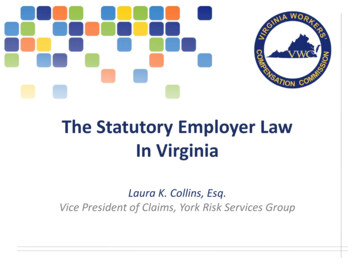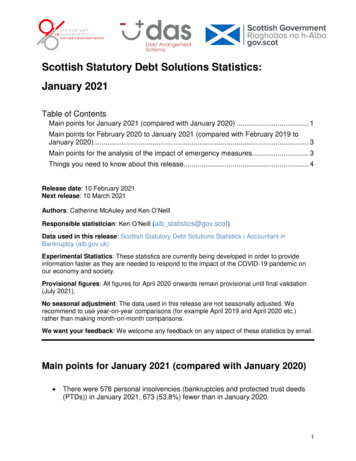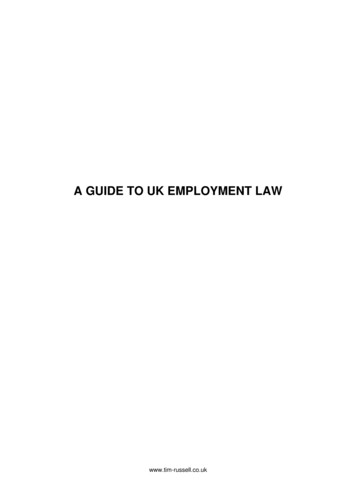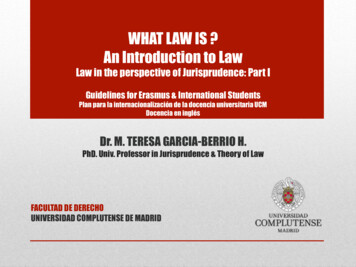
Transcription
The Statutory Employer LawIn VirginiaLaura K. Collins, Esq.Vice President of Claims, York Risk Services GroupStatutory Employer Law and Contractor Liability
Agenda Virginia Coverage Requirements Statutory Employer Law and Related Laws The Basic Tests Governmental Entity and Statutory Duty Industry Considerations Claim Considerations Coverage and Penalty ConsiderationsStatutory Employer Law and Contractor Liability2
Why is the Statutory Employer Law Important? Claim considerations Right to workers’ compensationRight to civil suitWhen to accept a claimWhen to denySubrogation and adding a party Coverageconsiderations Properly insuring Avoiding penaltyStatutory Employer Law and Contractor Liability3
Start by looking atcoverage requirementsStatutory Employer Law and Contractor LiabilityStatutory Employer Law and Contractor Liability4
Virginia Coverage RequirementsCoverage is required for more than two employees This is commonly known But there’s much more tocoverage requirements!Statutory Employer Law and Contractor Liability5
Virginia Coverage Requirements Statutory Employer law, § 65.2-302: A business that hires subcontractor(s) to perform the sametrade, business or occupation or to fulfill a contract must includethe subcontractor’s employees in determining total number ofemployees. Therefore, if the total of the business owner’s employees plusall subcontractor’s employees is more than two, coverage isrequired. Number of workers matters Whether it is direct employees or subcontractor’s employeesStatutory Employer Law and Contractor Liability6
Statutory Employer Law Purpose of the law To prevent an owner from escaping liability under the Act bysimply hiring subcontractors instead of employees To insure compensation coverage for employees of independentcontractors and subcontractors Important points Don’t overly focus on terms contractor or subcontractor Law refers to any person Person or business can hire a subcontractor or other personStatutory Employer Law and Contractor Liability7
Statutory Employer Law The law has four parts Complex legal language A B and C impose liability D provides one exception Primary Focus Parts A and BStatutory Employer Law and Contractor Liability8
Statutory Employer Law – Part A When a person performs or executes work foranother, and The work is part of his trade, business or occupation, and He contracts or subcontracts out any of the work Then the owner shall be liable to pay any worker employed in thework as if the worker were immediately employed by him Example Roofing contractor hires aroofing subcontractorStatutory Employer Law and Contractor Liability9
Statutory Employer Law – Part B When a person contracts to perform or execute workfor another person, and The work is not part of his trade, business or occupation And he contracts or subcontracts any part of the work Then he bears liability under the Act to any worker employed inthe work as if the worker were immediately employed by him Example Homebuilder sells houses Subcontracts out all of thework to subcontractors(foundation, electrical, etc.)Statutory Employer Law and Contractor Liability10
Statutory Employer Law – Part C When subcontractor on the job contracts withanother person To perform or execute any part of the subcontractor’s work Then the owner bears the same liability to workers as in A or B Example Homebuilder subcontractsout lot development Lot developer subcontractsout tree trimming Homebuilder is liable tothe worker performingtree trimmingStatutory Employer Law and Contractor Liability11
Statutory Employer Law – Part D Provides an exception for a person engaged in thebusiness of real property maintenance and repair, if: Work is performed on behalf of property owners Injured worker engaged in real property maintenance or repair Person / business had no employees in the same trade, businessor occupation as worker seeking compensation; and Person / business did not seek or obtain a profit from thehomeowners Limited case lawStatutory Employer Law and Contractor Liability12
Related LawsStatutory Employer Law and Contractor LiabilityStatutory Employer Law and Contractor Liability13
Exclusivity Provision § 65.2-307. Employee’s rights under the Act excludeall others Injured worker’s “exclusive remedy” with employer for a workinjury is workers’ compensation Employer is “Shielded” from civil suit by an employee Workers’ compensation provides limited benefits Test cases over the law or suits are workers filing civil suits oremployers wishing to be found to be statutory employers Reason: no non-economic damages in workers’ compensation Non-economic damages increase claim costs significantlyStatutory Employer Law and Contractor Liability14
Non-Economic Damages Civil suit often takes longer but damages arepotentially greater Pain and suffering Loss of consortium Loss of enjoyment of life Punitive damages can increase costs substantially Conduct must be found reckless or willful and wanton Awarded to punish employer Deter bad behaviorStatutory Employer Law and Contractor Liability15
Related laws § 65.2-309 - employer lien against 3rd partysettlement proceeds Reimburses employer compelled to pay (worker) by law Eliminates worker double recovery § 65.2-310 - employer protection in 3rd party suit Authorizes deducting a proportionate share of reasonableexpenses for attorney fees to reimburse paying attorney § 65.2-311 - provides for apportionment ofattorney fees and expense reimbursementStatutory Employer Law and Contractor Liability16
Related laws Locating a responsible third party can beadvantageous Right to reimbursement or lien Does require work and investigationStatutory Employer Law and Contractor Liability17
The Basic Tests(Statutory Employer Law)Statutory Employer Law and Contractor Liability18
The Basic Tests Normal Work Test Shell Oil case Subcontracted Fraction Test Part B – Statutory Employer law Stranger to the Work Test Allows a worker to sue an employerStatutory Employer Law and Contractor Liability19
Statutory Employer Tests Whether a person is a statutory employer presents amixed question of law and fact Look at the facts in each case Important to investigate and gather facts Two main questions to ask to figure out whichpart of the law applies Is the work the same tradeor business as the owner? Is there a contract oragreement?Statutory Employer Law and Contractor Liability20
Normal Work Test Shell Oil Co. v. Leftwich, 212 Va. 715, 187 S.E. 2d (1972) Shell Oil Co. appealed a Commission finding that they were astatutory employer The Facts just a few Robinson leased a station from Shell and employed LeftwichLeftwich was injured on a service call for the service stationThe wrecker he was in had a “Shell” emblemRobinson posted a Shell signThe service station sold Shell fuelStatutory Employer Law and Contractor Liability21
Normal Work Test The Test – from Larsons Not whether the subcontractor’s activity is useful, necessary oreven absolutely indispensable to employer’s business Test is whether work performed by subcontractor’s employees is“normally” performed by owner’s employees. Thus, the Normal Work Test Court considered Shell explores for oil, digs wellsRefines crude, transports in bulkDistributes to dealers & jobbersDoes not sell gas to the publicNot Shell’s normal workReversed, not a statutory employerStatutory Employer Law and Contractor Liability22
Subcontracted Fraction Test Cooke v. Skyline Swannanoa, Inc.,226 Va. 154, 307 S.E.2d 246 (1983) Restaurant worker was injured working, received workers’ comp. Filed a civil suit against Skyline, operating an Inn. Trial court ruled Skyline was Statutory employer. The Facts Cooke worked for Aberdeen Barn, a restaurantThe restaurant was located in an InnSkyline agreed to operate a Holiday InnEntered into a license agreementAgreed to provide lodging, foodand other accommodations.”Statutory Employer Law and Contractor Liability23
Subcontracted Fraction Test Which test to apply Cooke argued Skyline was not her Statutory Employer becauseits employees did not normally perform restaurant work.(normal work test) Supreme Court ruled The work Aberdeen Barn contracted to undertake is “obviously asubcontracted fraction” of Skyline’s agreement with Holiday Inn That is the correct test to apply. Affirmed. Cooke’s only remedy is workers’ compensationStatutory Employer Law and Contractor Liability24
Stranger to the Business Test Test applied to determine when an owner’semployee may file civil suit against subcontractor Test: is the subcontractor a stranger to the owner’s business? Whalen v. Dean Steel Erection Constr. Co.,229 Va. 164, 327 S.E.2d 102 (1985) Whalen was the Gen’l Contractor’s worker injured by the steelsubcontractor’s work Whalen filed a tort action against a subcontractor, this issue ofStatutory Employer went to the Supreme Court of Virginia Court ruling Dean Steel was no stranger to erecting buildings. Whalen barred from civil suit. His remedy was workers comp.Statutory Employer Law and Contractor Liability25
Stranger to the Business Test Test applied to determine when an owner’s employeemay file civil suit against subcontractor Test: whether subcontractor is a stranger to the owner’s business Stone v. Door-Man Manufacturing Co.,260 Va. 406, 537 S.E.2d 305 (2000) Ford worker injured at work in the course of his employment Attempted to drive thru doorway which closed, hit head and chest Files civil suit against the Overhead Door Co. Court ruling Door-Man Mfg. was a stranger to manufacturing and selling cars Therefore, worker Stone was allowed to proceed with a civil suitStatutory Employer Law and Contractor Liability26
Governmental EntityStatutory Employer Law and Contractor Liability27
Governmental Entity Jones v. Commonwealth,267 Va. 218, 591 S.E.2d 72 (2004) Jones worked for Waco as an asbestos abatement workerPerformed a job at University of VirginiaSuffered electrical shock injury removing conduitsBrought suit against the University for negligenceCommonwealth defended that UVA was a statutory employerStatutory Employer Law and Contractor Liability28
Governmental Entity or Public Utility Supreme Court opinion UVA owned the building where Jones was injured working “The liability as an owner for governmental entities and privateentities differs.” Any activity authorized or required is considered part of theentity’s trade, business or occupation. Noted that the normal work test is not applicable Governmental entity cannot choose its activities The University was Jones statutory employer. Trial court judgment affirmed. Tort claim barred.Statutory Employer Law and Contractor Liability29
Industry ConsiderationsStatutory Employer Law and Contractor Liability30
Industry Considerations Construction Construction industry has many statutory employersThis is evident in numerous hearing decisionsVWC also has a Contractor Compliance ProjectInsurance investigates uninsured entities that hire subcontractorsEducates contractors about coverage requirements; most obtaincoverage voluntarilyStatutory Employer Law and Contractor Liability31
Industry Considerations Property Maintenance Turf Care Inc. v. Henson, 51 Va. App. 318, 657 S.E.2d 787 (2008)Johnson worked for Turf Care, fell from a 40’ extension ladderTurf Care cared for the common areas in Windsor FarmsWindsor Farms was found to be a statutory employerStatutory Employer Law and Contractor Liability32
Industry Considerations Trucking Clean Sweep Professional Parking Lot Maintenance, Inc. v. Talley, 267 Va. 210, 591 S.E. 2d 79 (2004)Paving company paving part of I 95 for VDOTHired Coleman Trucking to assist in transporting asphaltTruck driver, Talley, injured responding to disabled truckTalley found to be statutory employee of Virginia Paving Co.Statutory Employer Law and Contractor Liability33
Claim ConsiderationsStatutory Employer Law and Contractor Liability34
Claims considerations Perform an independent investigation Ask questionsConsider the industryIs there a contract or agreement?Obtain and review any and all contracts or agreements Governmental entity or public utility? Is another business or employees on siteor involved? Consider the work performed by eachbusiness entityStatutory Employer Law and Contractor Liability35
Claim considerations Employer may not consider itself a (statutory)employer An injured worker can make claim against statutory employerClaim professional should evaluateMay accept or denyManage claimStatutory Employer Law and Contractor Liability36
Coverage ConsiderationsStatutory Employer Law and Contractor Liability37
Coverage Issues Statutory employers not always properly insured Some are intentionally uninsured due to the cost Some due to lack of understanding of coverage requirementswhich are complex Insurance Department experience Frequent employer and agent calls and questions Insurance compliance programs demonstrate a continuous levelof uninsured contractors requiring education, enforcement Claim filings VWC Judicial opinionsStatutory Employer Law and Contractor Liability38
Penalty Considerations Employers subject to the Act must properly insure § 65.2-805 provides a civil penalty for failing to insure of up to 250 per day uninsured, subject to a maximum of 50,000.00 Also liable to any employee for compensation (WC or lawsuit) In the event of suit employer not permitted several defenses If after hearing and continued noncompliance, Commission mayorder employer to cease and desist all business operations Other penalties § 65.2-806 provides for criminal penalties for an employer whoknowingly and intentionally fails to comply with the ActStatutory Employer Law and Contractor Liability39
Review Statutory Employer law broadens the definition ofemployer in Virginia Sword and a Shield Claim considerationsStatutory Employer Law and Contractor Liability40
Any Questions?Statutory EmployerBackstagePass: An InsideLaw andLookContractorat CommissionLiabilityRules, Policies and Procedures41
Contact information:Laura K. Collins, Esq.Vice President of ClaimsLaura.Collins@yorkrsg.comYork Risk Services Group(W) (804) 775-0717(M) 804 774-8609Statutory Employer Law and Contractor Liability42
Statutory Employer Law and Contractor Liability Statutory Employer Law - Part B 10 When a person contracts to perform or execute work for another person, and The work is not part of his trade, business or occupation And he contracts or subcontracts any part of the work Then he bears liability under the Act to any worker employed in










